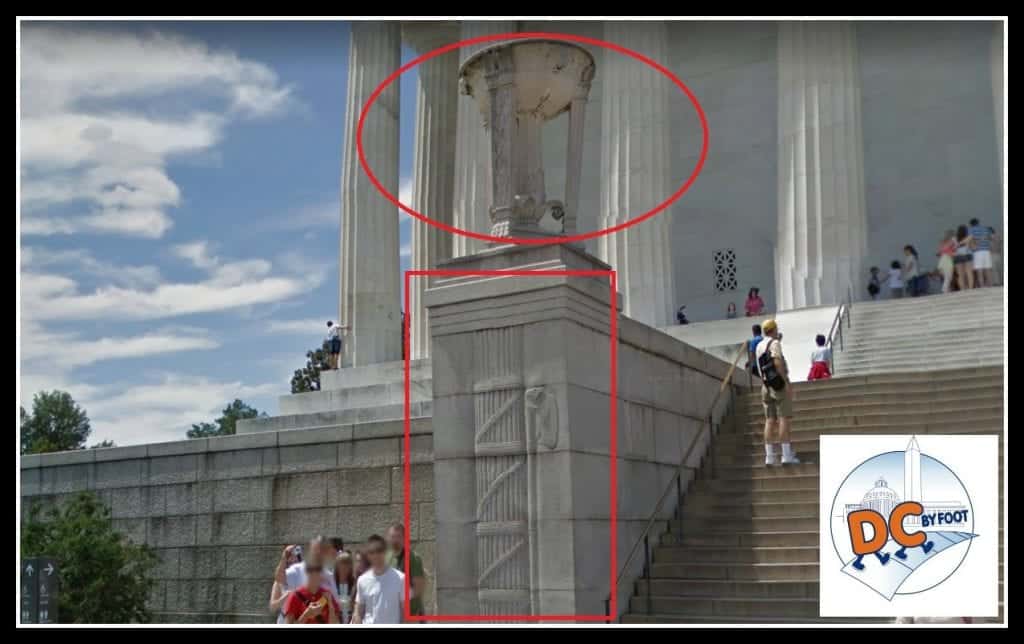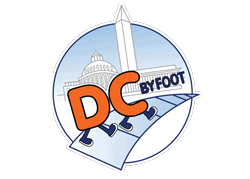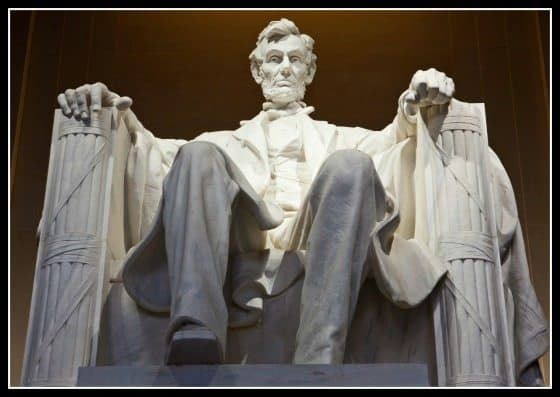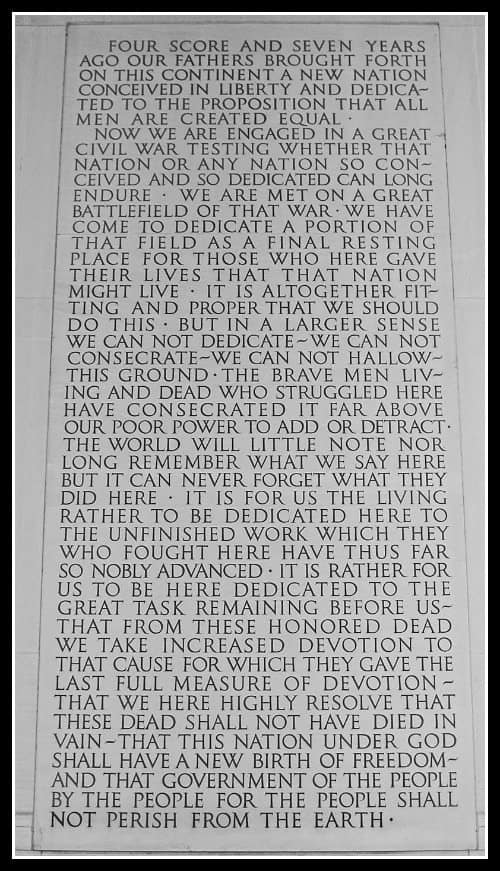This post is a guide to visiting the Lincoln Memorial in Washington, DC, including information on its architecture, symbolism, and myths.
I will also explain how you can tour the Lincoln Memorial, on your own, or with a group - maybe us, Free Tours by Foot.
As local walking tour guides, the Lincoln Memorial is like a second home to us. We are here every day!
We lead hundreds if not thousands of people each week into the memorial, and, the amazement in our guests' eyes when they see Lincoln for the first time, well, it never gets old.
Please use this post as a guide for your visit.
Below is a short and humorous 3-minute video, produced by one of our tour guides, summarizing what follows in this post.
PLAN YOUR VISIT
The Lincoln Memorial is free to visit open to the public all day and night with no tickets required.
Located at the far west end of the National Mall, it is next to the Vietnam Veterans Memorial, and Korean War Veterans Memorial, and the Albert Einstein Memorial.
There is no Metro station on this end of the National Mall, but the Lincoln Memorial is only a 10-12 minute walk from Foggy Bottom/GWU Station.
There is no parking lot at the memorials but I am usually able to find street parking in area.
Because so many people want to know how to get to the Lincoln Memorial, we have a whole post all about parking, public transportation, and directions.
TOURS OF THE LINCOLN MEMORIAL
Guided Tours
The Lincoln Memorial is a stop on our National Mall Tour (as well as our National Mall & Tidal Basin and Memorials and Moonlight versions)
We also have a GPS-enabled audio tour of the National Mall, which includes a stop at the Lincoln Memorial.
I think our tours of the Lincoln Memorial are one of the best ways as we will give you both a guided tour of the memorial as well as free time to take photos. For our younger visitors, we always include a scavenger hunt type mission - usually to find the spelling error!
All guided bus tours go to the Lincoln Memorial.
Several of the premium tour companies, such as USA Guided Tours, have a tour guide in addition to drivers, who will accompany you to the Lincoln Memorial for a guided walking tour.
Ranger Talks
Park Rangers provide "interpretive programs" on the hour every hour from 10 a.m. until 11 p.m.
The enjoyment factor depends greatly on who is giving the tour, as some rangers seem more interested than others, but they are usually all very informative. These talks are free.
The National Park Service has posted some of these talks under "reflections" on their Lincoln Memorial Interactive site.
One of the ranger talks that I have especially enjoyed are the runs with a ranger offered on select dates!
Mobile Phone Tour
The Park Service also offers a mobile phone tour of the memorial.
Dial (202) 747-3420 when you are at the memorial and enter the corresponding item number that you want to learn about.
App
The Park Service also offers a visitor's app for the National Mall for both Android and iPhone.
THE LINCOLN MEMORIAL
If you're interested in knowing more about the symbolism and history of the memorial, I've written up a guide with information that I share when leading the National Mall Tour!
Dedicated to the 16th President of the United States, the Abraham Lincoln Memorial sits at the western end of the National Mall looking down towards the Washington Monument and the U.S. Capitol.
The memorial itself was designed by Architect Henry Bacon and the famed statue of Lincoln was sculpted by Daniel Chester French and the Piccirilli brothers.
There are many aspects of the memorial but a few main highlights that I like suggest as must-sees while visiting are:
- Inscriptions:
- Gettysburg Address
- Lincoln's Second Inaugural Address
- Dr. King's "I Have A Dream" Plaque
- Reflecting Pool
- Statue of Abraham Lincoln
EXTERIOR ARCHITECTURE:
The Memorial is marble structure based on a temple in Athens, Greece known as the Parthenon.
The perimeter has 36 Corinthian order columns, one for each of the thirty-six states that made up the United States when Lincoln died.
There are two rows of state names. The lower level contains 36 states (matching the columns).
Starting from the left is Delaware, the first state to ratify the U.S. Constitution. Next is Pennsylvania (the second), and so on and so forth.
Interspersed between each state on the lower level is a wreath of northern laurel on top of the southern pine.
Despite laurel and pine being abundant in both the northern and southern states during the American Civil War, it would seem to be a subtle acknowledgment of the Union's victory over the Confederacy.
The upper row lists the 48 states of the United States of America in 1922, the year of the Memorial's dedication. At this time, Alaska and Hawaii were not yet states but they are recognized with a plaque on the steps.
Just above this row, one can see eagles, and Roman victory tripods with garland festoons.
On the plaza level, closest to the roadway, you will find a large bronze plaque commemorating Alaska and Hawaii becoming the 49th and 50th states of the union.

Most visitors to the memorial will go straight inside, totally oblivious to the features of the memorial hidden in plain sight.
However, these are actually important symbols.
They are Roman fasces, wooden rods tied together by leather, and the victory tripods found on both sides of the grand staircase. The first was a symbol of authority for Roman magistrates and was included to convey a similar executive authority of Lincoln.
The fasces found on the exterior of the memorial have an American flair with 13 rods (13 colonies) and an American bald eagle atop the ax. The fasces are also a symbol of unity; the individual rods, like the states, are weak, but unified, they are strong.
In fact, this symbol of the fasces is so important, that you will also see them inside on the walls and on the Lincoln statue itself.
During World War II, fasces would be very controversial, as the fascist government of Italy would choose fasces for both their name and flag.
The second is the victory tripods, an ancient Roman symbol of victory. These are adorned with Americana, tobacco, corn, and eagles.
Learn more about the secret symbols of the Lincoln Memorial.
![By ProhibitOnions; cropped by Beyond My Ken (talk) 01:40, 15 February 2012 (UTC) (Own work) [GFDL (http://www.gnu.org/copyleft/fdl.html)], via Wikimedia Commons MLK I have a dream Lincoln Memorial](https://freetoursbyfoot.com/wp-content/uploads/2020/06/MLK-I-have-a-dream-Lincoln-Memorial.jpg)
In the center of the last landing, before reaching the statue chamber, you will find an engraving "I Have a Dream."
The March on Washington for Jobs and Freedom, August 28, 1963. This marks the spot where Martin Luther King Jr delivered his famous speech.
Be sure to check out the Martin Luther King Jr. Memorial on the Tidal Basin, a 10-minute walk from the Lincoln.
Constructing the Lincoln Memorial was truly a national effort and included items from many different states, combining to form the whole, just as Lincoln would have wanted.
STATUE AND INTERIOR:
One of the most recognizable statues in the world, this colossus statue of Lincoln will impress you.
From the bottom of his feet to the top of his head, he measures 18 feet (5.5 m). If he were standing, he would stretch to 28 feet (8.5 m).
Due to the enormity of the statue, Lincoln's head is approximately 20% larger in proportion to his feet, otherwise, the human eye would see a head that was too small for the body.
Lincoln sits in a curule chair, a chair in ancient Rome that symbolized power and authority and was reserved for a magistrate.
Old Glory, the 36-star American flag of the Civil War is draped around the back of the chair.
Now take a look at the ends of the chair. At first glance, these two identical carvings appear to be the bindings of books. However, they are the fasces that you may have noticed outside.
The difference here is that we are inside the memorial. As with the inside of Rome's walls, the ax is prohibited.
The sculptor, Daniel Chester French, wanted to convey the two main qualities of Lincoln that he felt were important, Lincoln's thoughtful and compassionate nature (emancipation) as well as his forceful nature (prosecuting the Great War).
If you look away too fast, you might not notice that Lincoln is asymmetrical. Look closely and you will see that one side of Lincoln (your right) is tense while the other side is relaxed.
Take a look at his face, eyebrows, hands, and feet as well as his clothing. Notice the differences?
Behind him etched into the wall is a quote, "In this temple, as in the hearts of the people for whom he saved the Union, the memory of Abraham Lincoln is enshrined forever."
To Lincoln's right (contemplative and thoughtful) is his most enduring speech, the Gettysburg Address.
It was a short and poetic speech that recalled the ideals of representative government defined by the American Revolution and placed the preservation of these ideals as the cause of the Union in the Civil War while calling for a new birth of freedom.
Because the aim of the memorial was to celebrate the reunification of the northern and southern states over the emancipation of slaves, the symbols and images of the latter are secondary.
Click the image to enlarge.
Directly above the Gettysburg Address is the painting entitled Emancipation, painted by Jules Guerin.
According to the National Park Service, "Jules Guerin represents emancipation using allegorical images. At center, the Angel of Truth breaks the bonds of slavery. The seated figure to the left holds the sword of Justice and the scroll of Law. On the right sits Immortality attended by the standing figures of Faith, Hope, and Charity."
To Lincoln's left is his favorite speech, his second Inaugural Address. This is the speech he gave during the midst of the American Civil War when he was elected to the presidency for a second time.
The most famous line from this speech is "...charity towards all, malice towards none." This is also the speech that has a spelling error in it!
Myths about the Lincoln Memorial
There are a lot of interesting stories about the Lincoln Memorial, only some of which are proven true. Here are some of the common ones we've heard on tours.
Is there a face on the back of Lincoln's Head?
It is true that Robert E. Lee lived in Arlington House, which is directly across the river from the Lincoln Memorial.
It is also true that if you stand at the right angle and look at the profile of Lincoln's statue, it does look like the profile of Robert E Lee looking back on his own home.
It is not true however that this was done on purpose. Lincoln just had wavy hair!
Are Lincoln's hands in an A and L for his initials in American Sign Language?
Lincoln's hands do form two different shapes that look like an A and a L.
Sculptor Daniel Chester French did have a son who was deaf; however, there is no indication that French designed Lincoln's hands to reflect these two letters of the ASL alphabet.
Rather, Lincoln's statue is meant to portray two sides of the same man - the determined side (the fist) and the compassionate side (the relaxed hand)
Is there a misspelled word on the Lincoln Memorial?
This one is TRUE! Kind of, it has been fixed but you can still see it if you know where to look.
Was the Lincoln Memorial damaged during WWII?
Another true one! There was an accidental firing of a weapon in Washington, DC that damaged some of the exterior of the memorial. Look at the upper right corner where the states are listed and you'll see a section that looks a little cleaner and newer than the rest.
Is Lincoln buried under the Lincoln Memorial?
Nope. There is a lot of dust, graffiti, and asbestos down there but no presidential remains. Lincoln is buried in Springfield, Illinois.
RELATED POSTS:











